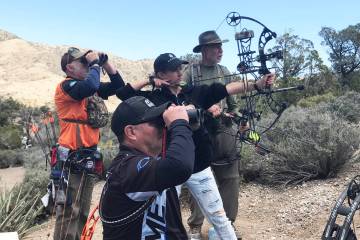When hunting big-game animals, look for what doesn’t belong
As Jed and Karen look out across the sage-covered flat, it seems vast and empty. Where they had seen antelope earlier, there were now none to be found.
It was a strange sight given the animal’s bright white and reddish-tan coloring; a trait that usually makes them stand out against the Central Nevada landscape.
Undaunted, the husband-and-wife team hunkers down behind their binoculars and begins picking the landscape apart. Then just as they are about to move on, Jed spots something that looks different than everything else, something that did not fit into the sea of sage. Something that doesn’t wave with the breeze.
There, a long rifle shot away in the sage, is the top half of a pronghorn buck’s horns but nothing more. Someone taking nothing more than cursory look across the landscape would probably fail to recognize the buck’s horn tips bending toward each other in that telltale heart shape common to the pronghorn.
Instead, they might mistake them for heavy branches of a sagebrush. But Jed’s look is a thorough one, and a long stalk later he looks on as Karen punches her tag and fixes it to the buck’s carcass.
When it comes to looking for big-game animals, hunters can often fall into the trap of looking only for the shape or color that matches a predetermined image of what their quarry should look like when standing in open area. While that is the logical place to start, things in the wild don’t always resemble what one might see in the pages of a hunting magazine or on the internet.
Oftentimes, all you see in the outdoors is a piece of your quarry through the brush or trees. Or perhaps something as quick as a glint of sunlight reflecting off an antler or even an animal’s back.
That was a valuable lesson I learned early in my hunting career. While hunting mule deer in the hills above Uncle Ron’s dry farm, I happened to catch a flash of light as something moved through the brush on top of a low ridge. Figuring the light was simply the reflection off another hunter’s firearm, I looked through my binoculars to see who had invaded my space.
To my surprise, however, it was not another hunter that was slipping through the brush but a couple of does along with their fawns. It was a valuable lesson.
When game animals are up and feeding, such as in the early morning or late afternoon, they can be relatively easy to pick out as you survey your surroundings. They will generally be feeding in an open space not far from escape cover or an escape route.
A thick stand of trees or a ridge line can provide either of those things. If they are on the move, all the better, but what if they are not feeding or moving?
That is where your optics and your ability to concentrate come into play. When your quarry isn’t up and about, they are either bedded down somewhere or holding in cover, and that means you will have to dig them out. Probably a piece at a time.
After finding a vantage point, use your binoculars to study the terrain. Rather than focusing on the stereotypical image of the game you are pursuing, look for something that does not fit with the surroundings.
It may be a contrasting shape or even a color. Something as simple as the flick of an ear can be all it takes to find a bedded game animal.
Don’t take anything for granted. What you think is the fork in a tree limb might just be the fork in a mule deer’s antlers. You may see more stump deer than you want to, but eventually you’ll find what you are looking for.
Freelance writer Doug Nielsen is a conservation educator for the Nevada Department of Wildlife. His “In the Outdoors” column is not affiliated with or endorsed by the NDOW. Any opinions he states in his column are his own. Find him on Facebook at @dougwritesoutdoors. He can be reached at intheoutdoorslv@gmail.com


















